The Bulldozer Review: AMD FX-8150 Tested
by Anand Lal Shimpi on October 12, 2011 1:27 AM ESTPower Management and Real Turbo Core
Like Llano, Bulldozer incorporates significant clock and power gating throughout its design. Power gating allows individual idle cores to be almost completely powered down, opening up headroom for active cores to be throttled up above and beyond their base operating frequency. Intel's calls this dynamic clock speed adjustment Turbo Boost, while AMD refers to it as Turbo Core.
The Phenom II X6 featured a rudimentary version of Turbo Core without any power gating. As a result, Turbo Core was hardly active in those processors and when it was on, it didn't stay active for very long at all.
Bulldozer's Turbo Core is far more robust. While it still uses Llano's digital estimation method of determining power consumption (e.g. the CPU knows ALU operation x consumes y-watts of power), the results should be far more tangible than what we've seen from any high-end AMD processor in the past.
Turbo Core's granularity hasn't changed with the move to Bulldozer however. If half (or fewer) of the processor cores are active, max turbo is allowed. If any more cores are active, a lower turbo frequency can be selected. Those are the only two frequencies available above the base frequency.
AMD doesn't currently have a Turbo Core monitoring utility so we turned to Core Temp to record CPU frequency while running various workloads to measure the impact of Turbo Core on Bulldozer compared to Phenom II X6 and Sandy Bridge.
First let's pick a heavily threaded workload: our x264 HD benchmark. Each run of our x264 test is composed of two passes: a lightly threaded first pass that analyzes the video, and a heavily threaded second pass that performs the actual encode. Our test runs four times before outputting a result. I measured the frequency of Core 0 over the duration of the test.
Let's start with the Phenom II X6 1100T. By default the 1100T should run at 3.3GHz, but with half or fewer cores enabled it can turbo up to 3.7GHz. If Turbo Core is able to work, I'd expect to see some jumps up to 3.7GHz during the lightly threaded passes of our x264 test:
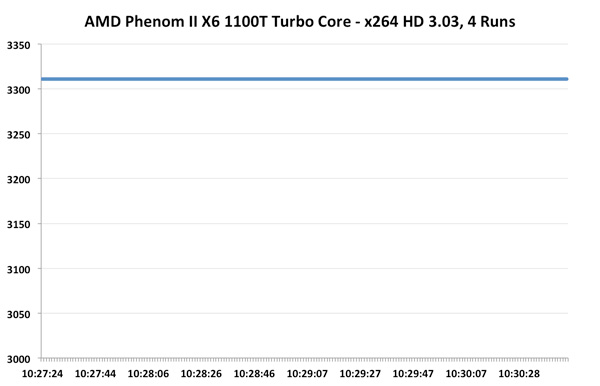
Unfortunately we see nothing of the sort. Turbo Core is pretty much non-functional on the Phenom II X6, at least running this workload. Average clock speed is a meager 3.31GHz, just barely above stock and likely only due to ASUS being aggressive with its clocking.
Now let's look at the FX-8150 with Turbo Core. The base clock here is 3.6GHz, max turbo is 4.2GHz and the intermediate turbo is 3.9GHz:
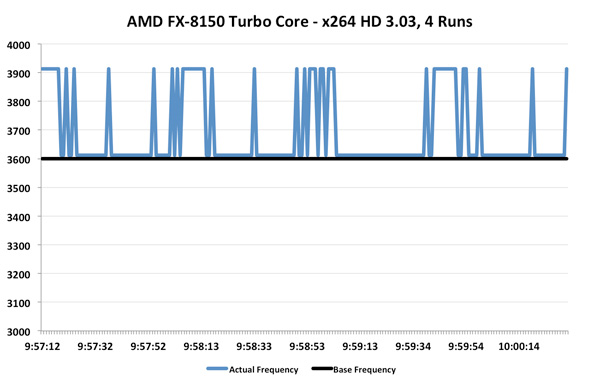
Ah that's more like it. While the average is only 3.69GHz (+2.5% over stock), we're actually seeing some movement here. This workload in particular is hard on any processor as you'll see from Intel's 2500K below:
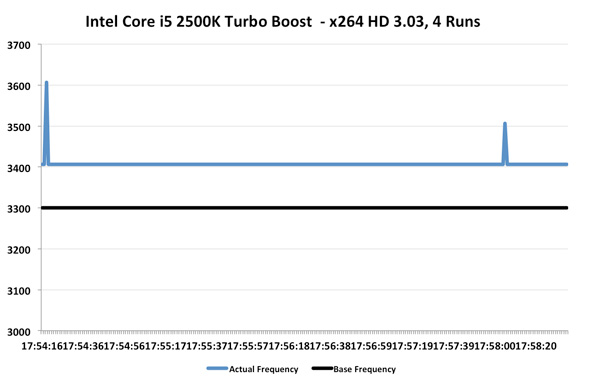
The 2500K runs at 3.3GHz by default, but thanks to turbo it averages 3.41GHz for the duration of this test. We even see a couple of jumps to 3.5 and 3.6GHz. Intel's turbo is a bit more consistent than AMD's, but average clock increase is quite similar at 3%.
Now let's look at the best case scenario for turbo: a heavy single threaded application. A single demanding application, even for a brief period of time, is really where these turbo modes can truly shine. Turbo helps launch applications quicker, make windows appear faster and make an easy time of churning through bursty workloads.
We turn to our usual favorite Cinebench 11.5, as it has an excellent single-threaded benchmark built in. Once again we start with the Phenom II X6 1100T:
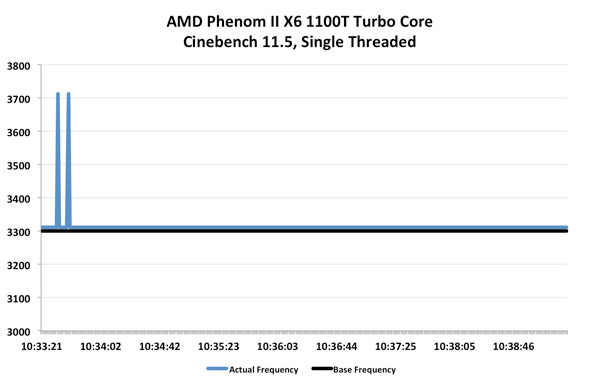
Turbo Core actually works on the Phenom II X6, albeit for a very short duration. We see a couple of blips up to 3.7GHz but the rest of the time the chip remains at 3.3GHz. Average clock speed is once again, 3.31GHz.
Bulldozer does far better:

Here we see blips up to 4.2GHz and pretty consistent performance at 3.9GHz, exactly what you'd expect. Average clock speed is 3.93GHz, a full 9% above the 3.6GHz base clock of the FX-8150.

Intel's turbo fluctuates much more frequently here, moving between 3.4GHz and 3.6GHz as it runs into TDP limits. The average clock speed remains at 3.5GHz, or a 6% increase over the base. For the first time ever, AMD actually does a better job at scaling frequency via turbo than Intel. While I would like to see more granular turbo options, it's clear that Turbo Core is a real feature in Bulldozer and not the half-hearted attempt we got with Phenom II X6. I measured the performance gains due to Turbo Core across a number of our benchmarks:

Average performance increased by just under 5% across our tests. It's nothing earth shattering, but it's a start. Don't forget how unassuming the first implementations of Turbo Boost were on Intel architectures. I do hope with future generations we may see even more significant gains from Turbo Core on Bulldozer derivatives.
Independent Clock Frequencies
When AMD introduced the original Phenom processor it promised more energy efficient execution by being able to clock each core independently. You could have a heavy workload running on Core 0 at 2.6GHz, while Core 3 ran a lighter thread at 1.6GHz. In practice, we felt Phenom's asynchronous clocking was a burden as the CPU/OS scheduler combination would sometimes take too long to ramp up a core to a higher frequency when needed. The result, at least back then, was that you'd get significantly lower performance in these workloads that shuffled threads from one core to the next. The problem was so bad that AMD abandoned asynchronous clocking altogether in Phenom II.
The feature is back in Bulldozer, and this time AMD believes it will be problem free. The first major change is with Windows 7, core parking should keep some threads from haphazardly dancing around all available cores. The second change is that Bulldozer can ramp frequencies up and down much quicker than the original Phenom ever could. Chalk that up to a side benefit of Turbo Core being a major part of the architecture this time around.
Asynchronous clocking in Bulldozer hasn't proven to be a burden in any of our tests thus far, however I'm reluctant to embrace it as an advantage just yet. At least not until we've had some more experience with the feature under our belts.


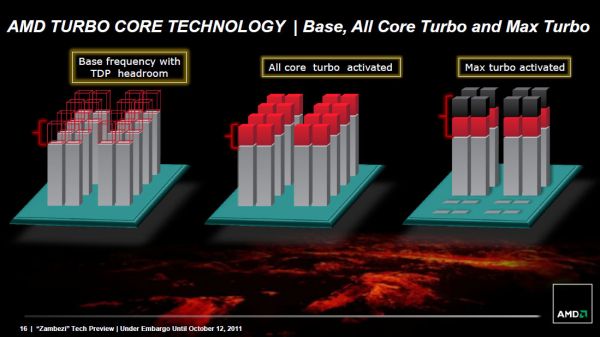








430 Comments
View All Comments
psiboy - Monday, February 6, 2012 - link
What kind of retarded person would benchmark at 1024 x 768 on an enthusiast site where every one owns at least 1 1920 x 1080 monitor as they are 1. Dirt cheap and 2. The single biggest selling resolution for quite some time now... Real world across the board benches at 1920 x 1080 please!mumbles - Sunday, February 12, 2012 - link
I am not trying to discount the reviewer, the performance of Sandy Bridge, or games as a test of general application performance. I have no connection to company mentioned really anywhere on this site. I am just a software engineer with a degree in computer science who wants to let the world know why these metrics are not a good way to measure relative performance of different architectures.The world has changed drastically in the hardware world and the software world has no chance to keep up with it these days. Developing software implementations that utilize multiprocessors efficiently is extremely expensive and usually is not prioritized very well these days. Business requirements are the primary driver in even the gaming industry and "performs well enough on high end equipment(or in the business application world, on whatever equipment is available)" is almost always as good as a software engineer will be allowed time for on any task.
In performance minded sectors like gaming development and scientific computing, this results in implementations that are specific to hardware architectures that come from whatever company decides to sponsor the project. nVidia and Intel tend to be the ones that engage in these activities most of the time. Testing an application on a platform it was designed for will always yield better results than testing it on a new platform that nobody has had access to even develop software on. This results in a biased performance metric anytime a game is used as a benchmark.
In business applications, the concurrency is abstracted out of the engineer's view. We use messaging frameworks to process many small requests without having to manage concurrency at all. This is partly due to the business requirements changing so fast that optimizing anything results in it being replaced by something else instead. The underlying frameworks are typically optimized for abstraction instead of performance and are not intended to make use of any given hardware architecture. Obviously almost all of these systems use Java to achieve this, which is great because JIT takes care of optimizing things in real time for the hardware it is running on and the operations the software uses.
As games are developed for this architecture it will probably see far better benchmark results than the i series in those games which will actually be optimized for it.
A better approach to testing these architectures would be to develop tests that actually utilize the strengths of the new design rather than see how software optimized for some other architecture will perform. This is probably way more than an e-mag can afford to do, but I feel an injustice is being done here based on reading other people's comments that seem to put stock in this review as indication of actual performance of this architecture in the future, which really none of these tests indicate.
I bet this architecture actually does amazing things when running Java applications. Business application servers and gaming alike. Java makes heavy use of integer processing and concurrency, and this processor seems highly geared towards both.
And I just have to add, CINEBENCH is probably almost 100% floating point operations. This is probably why the Bulldozer does not perform any better than the Phenom II x4.
Also, AMD continues to impress on the value measurement. Check out the PassMarks per dollar on this bad boy:
http://www.cpubenchmark.net/cpu.php?cpu=AMD+FX-815...
djangry - Sunday, February 19, 2012 - link
Beware !!!! this chip is junk.I love Amd with all my heart and soul.
This fx chip is a black screen machine.
It breaks my heart to write this.
I am sending it back and trying to snag the last x6 phenom 2 's
I can find.
The fact that this chip is a dud is too well hidden.
When I called newegg they told me your the second one today with
horror stories about this chip.
msi would not come clean ...this chip is a turkey....
yet they were nice.
I will waste no more time with this nonsense.
my 754's work better.
We need honesty about the failure of this chip and the fact windows pulled the hot fix.
tlb bug part two.
Even linux users say after grub goes in Black screens.
Why isn't the industry coming clean on this issue.
Amd's 939 kicked Intel butt for 3 years- till they got it together,we need Amd ,but I do not like hidden issues and lack of disclosure.
Buyer beware!
AMDiamond - Monday, March 5, 2012 - link
Guys you are already upset because you spent your lunch money on Intel and even with higher this and that boards and memory AMD (even with half as much memory onboard [32GB] & Intel has [64GB] ) Intel is misquoting thier performance again...no matter what you say AMD= Dodge as to Intel=Cheverolet ..and when it gets down to AMD on the game versus Intel ...Intel has another hardcore asswhipping behind and ahead... its the same thing as a Dx4 processor(versus the pentium) even though Pentium had 1 comprehesion level higher ..when running the same programs DooM for example Pentium couldn't run DooM anywhere near as good as a simple DX4 amd..same stays true ...this Bulldozer has already broken unmatched records...AMD only lacks in 1 area..when you install windows the intel drivers already match at least 80 percent performance of Intel ...where AMD needs a specific narrow driver to run...once that driver is matched ..AMD =General Lee versus (Smokey & the) Bandits POS =Intel's comaro and its true ashamed that Intel even with 2x as much ddr3 memory ..cant even pickup the torch when AMD is smoking a Jet on the highway to hell for Intel -Hahahamauhahaha...sorry as intel qx9650 ahahahaahahahahahahahhahahahAMDiamond - Monday, March 5, 2012 - link
watch AMD take Diablo 3 (1 expansion by the next/it will be so ) Intel always lags hard on gaming compared to a weaker AMD class...point proven ...everest has alot of false benchmarks for Intel example NWN2 Phenom x3 8400 (triple core hasa bench 10880) yet a Intel Core 2 Duo e7500 has a bench of 12391 thats a 2.9ghtz cpu versus a 2.1ghtz CPU ..ok the kicker is intel is a dell amd is an aspire..DDR2 memory on the AMD and ddr3 memory on the intel ..all the intel bus features say higher (like they always do) but try running the same dammned video board on both systems then try running 132 NWN2 maps each medium size...no way the intel can do it ..the AMD can run the game editor and the maps at once..Intel is selling you a number AMD is selling you true frames per second..but your going to say oh but my Intel is a better core and this and that..ok now lets compare the price of the 2 systems...Intel was $2,500 the AMD was $400 ..why do you think that phenom just stomps the ass off that intel?(always has always will)zkeng - Wednesday, May 9, 2012 - link
I work as a building architect and use this CPU on my Linux workstation, in a Fractal Design define mini micro atx case, with 8GB ram and AMD radeon hd 6700 GPU.I usually have several applications running at the same time. Typically BricsCAD, a file manager, a web browser with a few tabs, Gimp image editor, music player, our business system and sometimes Virtualbox as well with a virtual machine.
I do allot of 3D projects and use Thea Render for photo rendering of building designs.
I use conky system monitor to watch the processor load and temperature.
These are my thoughts about the performance:
Runs cool and the noise level is low, because the processor can handle several applications without taking any stress at all.
Usually runs at only a few % average load for heavy business use (graphics and CAD in my case).
When working you get the feeling that this processor has good torque. Eight cores means most of the time every application can have at least one dedicated core and there is no lag even with lots of apps running. I think this will be a great advantage even if you use allot of older single core business applications.
The fact that this processor has rather high power consumption at full load is a factor to take into consideration if you put it under allot of constant load (and especially if you over clock).
For any use except really heavy duty CPU jobs (compiling software, photo rendering, video encoding) temporary load peaks will be taken care of in a few seconds, and you will typically see your processor working at only 1,4 GHz clock frequency. When idle the power consumption of this CPU is actually pretty low and temporary load peaks will make very little difference in total power consumption.
I sometimes photo render jobs for up to 32 hours and think of myself as a CPU demanding user, but still most of the time when my computer is running, it will be at idle frequency. I consider the idle power consumption to be by far the most important value of comparison between processors for 90% of all users. This is not considered in many benchmarks.
It is really nice to fire up Thea Render, use the power of all cores for interactive rendering mode while testing different materials on a design and then start an unbiased photo rendering and watch all eight cores flatten out with 100% load at 3,6 GHz.
Not only does this processor photo render slightly faster compared to my colleagues Intel Sandy Bridge. What is really nice is that i can run, lets say four renderings at the same time in the background, for a sun study, and then fire up BricsCAD to do drawing work while waiting. Trying to do this was a disaster with my last i5 processor. I forced me to do renderings during the night (out of business hours) or to borrow another work station during rendering jobs because my work station was locked up by more than one instance of the rendering application.
....................
To summarize, this is by far the best setup (CPU included) I have ever used on a work station. Affordable price, reasonably small case, low noise level, completely modular, i will be able to upgrade in the future without changing my am3+ mother board. The CPU is fast and offers superb multi tasking. This is the first processor I have ever used that also offers good multi tasking under heavy load (photo rendering + cad at the same time)
This is a superb CPU for any business user who likes to run several apps at the same time. It is also really fast with multi core optimized software.
AMD FX-8150 is my first AMD desktop processor and I like it just as much as I dislike their fusion APUs on the laptop market. Bulldozer has all the power where it is best needed, perfectly adopted to my work flow.
la'quv - Wednesday, August 29, 2012 - link
I don't know what it is with all this hype destroying amd's reputation. The bulldozer architecture is the best cpu design I have seen in years. I guess the underdog is not well respected. The bulldozer architecture has more pipelines and schedulers that the Core 2. The problem is code is compiled intel optimized not amd optimized. These benchmarks for a bunch of applications I don't use have no bearing on my choice to by a cpu, there are some benchmarks where an i5 will outperform and i7 so what valid comparison's are we making here. The bulldozer cpu's are dirt cheap and people expect them to be cheaper and don't require high clock speed ram and run on cheaper motherboards. AMD is expected to keep up with intel on the manufacturing process. Cutting corners and going down to 32nm then 22nm as quickly as possible does not produce stable chips. I have my kernel compiled AMD64 and it is not taxed by anything I am doing.brendandaly711 - Friday, September 6, 2013 - link
AMD still hasn't been able to pull out of the rut that INTEL left them in after the Sandy Bridge breakthrough. I am a (not so proud) owner of an FX-4100 in one of my pc's and an 8150 in the other. The 4100 compares to an ivy bridge i3 or a sandy bridge i5. I will give AMD partial credit, though, the 8150 performs at the ivy bridge's i5 level for almost identical prices.Nfarce - Sunday, September 20, 2020 - link
And here we are in 2020 some 9 years after this review and 7 years after your comment and AMD still hasn't been able to equal Intel as an equal gaming performance contender. AMD's only saving face is the fact that now higher resolution demands of 1440p and now 4K essentially make any modern game CPU bound and more dependent on the GPU power.BlueB - Wednesday, October 5, 2022 - link
I always come back to this review every few years just to have a good laugh looking back at this turd architecture, and especially at genius comments like:"You don't get the architecture"; "it's a server CPU"; "it's because Windows scheduler"; etc., etc.
No, it wasn't any of those things. The CPU's a turd. It was a turd then, it's a turd now, and it will be a turd no matter what. It wasn't more future-proof than either Sandy or Ivy, 2600Ks from 11 years ago still run circles around it in both single and multi-threaded apps, old and new. The class action lawsuit against AMD was the cherry on top.
It really never gets old to read through the golden comment section here and chuckle at all the visionary comments which tried to defend this absolute failure of an architecture. It's an excellent article, and together with its comment section will always have a special place in my heart.